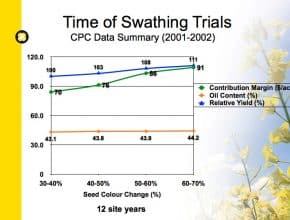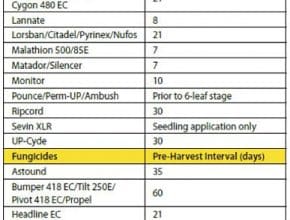Practice leads to perfect. Growers who successfully straight combine say that experience leads to success. If straight combining for the first time in 2011, be sure to start on a small number of acres. This will allow for some experimentation to determine how to make it work with an individual’s equipment. Choose suitable fields. Fields that make good candidates for…
Harvest
-
-
With uneven maturity and later canola crops, this will be another year to watch green counts. Here are some tips to follow when testing for green seed: Rather than start up the combine to take a sample, insert a scoop shovel underneath the swath and use your hands to thresh pods near ground level into the shovel. These plants will…
-
Combining has begun in some areas and high temperatures are predicted across the west in the coming days. It is important to remember that canola storage can be a concern……
-
Cooler overnight temperatures (in the neighborhood) of 1 to 2 C occurred overnight Monday into Tuesday in parts of Alberta. These cooler temperatures will not affect canola crops significantly. Growth chamber research shows that seed enzyme effects could be impeded with temperatures at 1 C which resulted in higher green seed…
-
Seed colour change is an indication of moisture dry down. The following is an estimate of canola seed dry down rates during ripening based on research of weather conditions during mid-August to early September in different areas across the Prairies…
-
Swathing is about to become general in Manitoba and proper timing is tricky in parts of Saskatchewan and Alberta because of variable staging. The following are some tips to help……
-
The ideal time to swath for yield and quality is when 50-60% of seeds on the main stem are turning color. At this stage, most seeds on the side branches will have reached maturity and will ripen in the swath. This may not be a safe assumption when very low plant counts result in heavily branched canola plants…
-
Growers considering a pre-harvest glyphosate cannot apply it to canola (RR or non-RR) until seed moisture drops to 30% or lower. This roughly coincides with 30% seed colour change. Spraying earlier raises the potential for glyphosate residue in seed…
-


